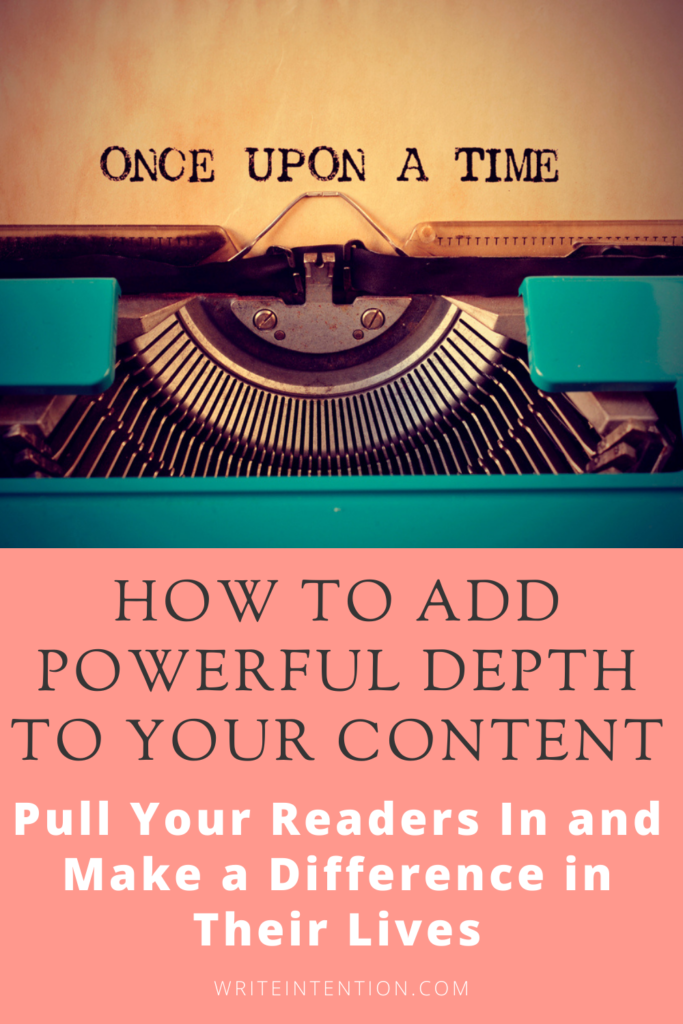Whether you are writing a chapter in your book or a blog post, if you want to be a transformational author and leader, you want your content to resonate with your readers. You want your content to have depth.
Content that has depth really pulls the reader in, giving them pause to think and evaluate your words more carefully. They aren’t skimming through your piece of work quickly because what you’re sharing is meaningful. This is the exact scenario you want as a transformational author.
A mistake that many new authors and solopreneurs make is that they think in terms of volume (word count) or consistency in posting content, but sometimes overlook the quality and depth of their writing.
When you’re able to create attention-pulling content – the kind that keeps readers interested, you’ll develop a loyal audience that stays tuned in to what you have to say.
In-depth content is not fluff and filler. You don’t want to bulk up content volume when you’re talking about depth. You want to enrich the content you’re sharing. One of the best ways to do this is through story telling.
Storytelling adds layers of depth that pure facts and figures can’t compete with. No one wants to sit down and read an encyclopedia. But they do like to hear people recount their stories of how life has unfolded for them.
We will discuss some of the best ways you can go about doing this as well as some mistakes you want to avoid along the way.
Telling Other People’s Stories
 Using case studies, vignettes or stories about people you know intimately can be used in your books, articles and other content however you must go about it a certain way. You have to be careful not to violate other’s confidentiality and right to privacy.
Using case studies, vignettes or stories about people you know intimately can be used in your books, articles and other content however you must go about it a certain way. You have to be careful not to violate other’s confidentiality and right to privacy.
One thing you want to avoid with in depth content is sharing someone else’s private stories and naming them or making it obvious of who it is. Even if it’s a positive slant, and not a negative one, you want to ensure that you’re not crossing any boundaries by shining a light on someone who may not have wanted that information out there.
This could be tricky, especially when writing the “your story” section of your book or if writing a memoir. You should always ask permission to share personal information about someone else that you intend to write about in your book or blog content. If this isn’t possible then you should not be sharing anything that can shine on a light on them.
For example, you wouldn’t want to say, “My sister has cried every night about her weight, but she refuses to do anything about it and won’t accept help from anyone. She’s been depressed and yet still shoves cookies in her mouth day after day.”
If someone happens to know your sister, or she sees it, this story could be very painful and humiliating. If your sister’s story is relevant and really adds value to your book/article, then change some of the details and don’t reveal it is your sister. You can take the essence of her story and create an anonymous vignette.
For example, you might say something like, “In my work with women who are overweight, I see many of them struggling to the point where they are crying themselves to sleep at night about their chronic weight gain. But then the next day, they are at the drive-thru or bakery stocking up on the very foods that are keeping them depressed, isolated and gaining weight. When help is offered, they are quick to decline or say something like, “I’ve already tried that and it won’t work”.
What this example illustrates is how to take inspiration from your sister’s story and perhaps some other clients or friends in a similar situation and create a general but accurate portrayal of someone who is struggling with their weight and potential food addiction.
So basically, you are sharing a version of her story anonymously by making sure it’s generic enough that no one would know exactly who you’re talking about. The vignette still adds value and is truthful – it is just a compilation of people you have known or worked with.
Another example in a different niche might be, “I once knew of a woman who was evicted from her home because she couldn’t pay her mortgage on a meager salary. She actually lived in a shelter while learning to start her business online, and used the library computer to get started. Now, she’s a six-figure blogger who helps others.”
That’s a very specific story, but it doesn’t tell who the person is.

Making Up a Story/Case Study/Vignette to Illustrate a Point
 You can also use made up scenarios. Often, when you create a story (and yes, it’s okay to tell them to imagine something), the words you put out there might paint a picture of someone reading it.
You can also use made up scenarios. Often, when you create a story (and yes, it’s okay to tell them to imagine something), the words you put out there might paint a picture of someone reading it.
This is slightly different than the previous example because this isn’t based on anyone’s story/experiences. You are making up a scenario to illustrate a point in an effort to help the reader understand their mindset/behavior on a deeper level.
So, let’s say your content piece already tells people not to give up on their dream and goal of losing weight. You might add a layer of depth by showing them how defeated someone feels when they give up and have to start all over. This is not a story about anyone you know – it is just a scenario to help them gain insight into their own behavior.
You could say, “Imagine you mess up your diet today and throw up your hands, tired of the struggle. In a couple of weeks, the weight you’ve lost will creep back on. Your pants will get snug again. You’ll feel uncomfortable in your own skin. You’ll cry because you’re so disgusted with yourself for failing again. Wouldn’t it feel better to view it as a one meal blip and power through the rest of your day or week and be proud that you didn’t go back to square one?”
Those reading this made-up example will probably see themselves in the scenario because they’ve been through it before. And even if not, it will be something they want to avoid doing when they slip up. They will remember your story and perhaps it will help them to be able to move on with their healthy eating plan rather than throw away all of their progress.
You can also add a layer of depth by talking about things that are already public. For example, if there is a story about a celebrity losing or gaining weight, you can use that as an example. Or if it’s a niche like survival, you might discuss a true crime story and how that person could have protected themselves.
The bottom line is, the depth of stories that you share should be appropriately placed and should be your own tales to tell. Always make sure you’re not stepping on anyone else’s toes when you’re looking to enrich a piece of content with a real-life case study or story.
Pull Readers in With Your Stories
 A great way to create in-depth content that pulls readers in is to start with your personal experiences. You probably chose your niche because it had some sort of personal appeal to you.
A great way to create in-depth content that pulls readers in is to start with your personal experiences. You probably chose your niche because it had some sort of personal appeal to you.
This is different from our previous discussion because the stories you are focusing on are yours not someone else’s.
This would be great for so many niches:
- someone who lost weight and now wants to help others
- someone who was caught unprepared in an extreme weather event and now guides others to be ready in the survival niche
- someone who struggled with a significant loss and now helps others work through their own grief
- someone who was once penniless and who now helps others earn money while working at home.
You can also share stories about your fears, hopes and “what ifs”. It doesn’t always have to be something that you’ve experienced. It can be something you want to avoid or something you hope to achieve.
If you’re talking about fears and hopes in the survival niche, for example, you might talk about how you hope someday society can once again sleep with their doors unlocked and windows open, but until then, you have to assume the worst could happen and protect yourself and your family.
Just speaking about it from an emotional point of view, showing that it truly means something to you, can help your audience bond with you, because it’s something that’s important to them as well.
Don’t Be Shy About Creating Depth with Opinions
 Some people hesitate to add opinions to their content pieces. They may feel just fine about sharing facts and data, but forming an opinion means putting themselves out there for judgment.
Some people hesitate to add opinions to their content pieces. They may feel just fine about sharing facts and data, but forming an opinion means putting themselves out there for judgment.
That’s because when it comes to opinions, there will always be someone who disagrees with you – someone who thinks differently from you. That can create controversy and arguments, because people can be foolish online and be hateful about things.
But still, your insight – your opinion – is what your audience wants to hear from you. They can get facts and figures anywhere. What makes your book or blog unique, as well as your courses and coaching programs, is that they get to find out why you believe something is right or wrong or the best way to do things.
So, start by sharing what you love about things. There will always be people who don’t love those things, but that’s okay. There will be plenty who think like you do. What do you love about a particular diet? About a method of gardening? About a specific dog training technique?
When you’re talking about what you love about it, it’s okay to be emotional. Emotional doesn’t mean you’re out there crying and hysterical. It means you’re thoughtful and genuine.
You can say that you love a mindful diet because, for the first time since you’ve been overweight, you didn’t feel like an outcast at dinner parties having to turn down foods the host had prepared – or whatever it is that resonated with you.
Likewise, talk about what you don’t like about something. Do you hate the way the keto diet makes you feel gross for eating blobs or butter and fattening slabs of bacon? It’s okay to say it – even if others will disagree because that’s exactly what they love about it.
Also add layers by talking about things you wish could be different or things you think are ridiculous. For example, you might discuss how you hate the diet obsessed mind people get, where everything they talk about and share is food, when the whole purpose is to get to a place of normalcy where food is fuel and not the center of their world.
When you add layers through opinions, you’re going to have plenty of people shaking their head in agreement and those who get frustrated and let you know how wrong you really are. Just think of it as engagement – and watch as those who agree with you step up in defense of that thought process.
Watch Your Content Tone
When you’re adding depth to your content, you want to make sure the tone you’re using comes across the right way. Because many of the depth elements are personalized, it’s tempting to covey it the same way you would speak to a friend.
There’s a difference between being conversational and stuffy. But if you’re writing in a conversational manner, which people do relate to, make sure you’re not going overboard with the slang.
So, let’s take a look at all three tones when adding depth and storytelling to your piece of content. Let’s say you’re writing about the dangers of being overweight, and you want to share your thoughts on it.
- This would be too conversational: “Like, I was overweight, you know? And that belly fat was gonna kill me!”
- This would be too stuffy: “The ominous peril that one puts him or herself in upon eating poorly and allowing the accumulation of pounds to gather on their frame is not worth the potential loss of life.”
- The right kind of conversational depth for your story would be something like this: “Having been overweight myself, I knew the danger I was in when I found myself struggling to climb the stairs.”
You want your personalized stories to come across as genuine, without looking sloppy or condescending. The third type of tone will allow your readers to see the picture you’re painting for them, and feel a connection with you, while maintaining respect for you as a leader in your niche.
Drill Down the Details
Another way you can add layers of depth is by drilling down the details about your topic. When you’re sharing information, you can provide it in a shallow way, such as saying, “Survivalists will need a knife in their bug out bags.”
That’s merely a surface- level way to guiding your audience. A deeper way to lead them would be by saying something like, “Survivalists will need a knife in their bug out bag to cut brush, hunt for food, for defense, to make tools, for cutting kindling for a fire, or to build shelter.”
That gives them a lot more information about why they need that knife in their bug out bag – things they may not have even thought of. When you write a statement, ask yourself if you could share more – like who it’s for, why they’d need it, what they’d need it for, and so on.
If you want to go even deeper, you could add to that statement, “The best knife for brush would be a machete. For shelter, you’d want a serrated knife instead of a plain edge.”
You can add as many details that are relevant and valuable to your readers as you want, as long as you don’t start going off on a tangent that will make it appear like fluff and filler content they don’t need.
For example, I once read an article by a fitness pro on how to create your own walking for weight loss program. I was excited to learn how to create a program like this but unfortunately the article had too many unnecessary details.
The author spent multiple paragraphs detailing walking gear right down to the types of shoelaces you should buy. By the time I got through those paragraphs I was overwhelmed and had no interest in reading further. The author could have easily mentioned a couple or brands and models of shoes and left it at that. The excessive detail was too much and really unnecessary.
Always be mindful of the goal of your content piece and the amount of detail you are including. Ask yourself if it is adding value or unnecessary filler.
Start Simple and Try It Out
If you want to try your hand at adding depth to some of your content pieces, pick a topic for your niche and write a simple 400-word article. Then go back and add depth wherever possible.
Try using a variation – your story, opinions, drilled down details, etc. Compare the length and feel of the piece before and after. Think about it from your readers’ point of view – which piece would you appreciate more?
There are certainly many other ways to add depth to your content – these are just a few ways to get you going. Don’t be afraid to experiment with your story telling – it’s a great way to make the connections you need to grow a loyal audience.
![]()

